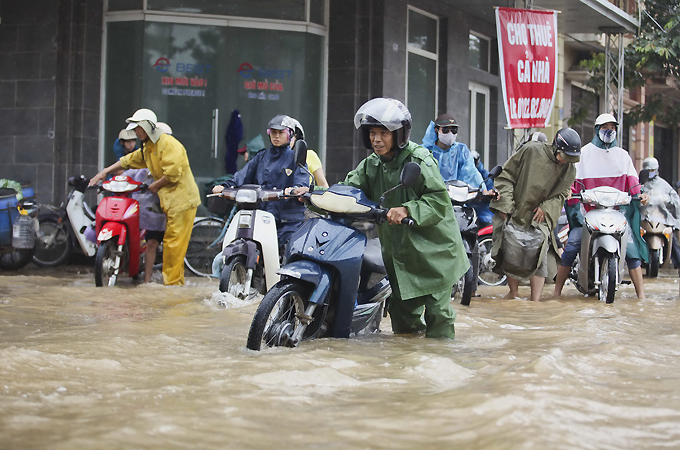We’ve aggregated together this past week’s notable news for the weekly round up, and there’s certainly a lot to catch up on. Check it out below.
Thousands of Vietnam soldiers on standby for Typhoon
Typhoon Kai-Tak, which has already ravaged the Philippines and parts of China, is now expected to make landfall in Vietnam. Winds may billow through Vietnam’s coast at speeds up to 133 kilometers an hour (83 mph) and 20,000 soldiers, eight helicopters, 72 rescue boats, 400 vehicles and 1000 canoes have been prepared to preempt against disaster. We hope everyone will stay safe and people’s sources of livelihood won’t be damaged.
Update: The typhoon ended up taking the lives of 17, and thousands of homes were damaged. But it is beginning to subside.
In Vietnam, power appetite outruns availability
Intermittent and unpredictable energy use has long been an image associated with the developing world. The recent half-country, 2-day black out in India particularly underscored how many emerging countries still struggle with dated infrastructure and unsustainable energy. Though no energy crisis of that magnitude has happened to Vietnam, the country’s energy needs are still not being met. Once an energy exporter, Vietnam now “relies mainly on thermal sources and hydropower for its electricity…Thermal generation accounts for 73%, of which natural gas made up 44%, coal 27% and oil-fired generation 2%. Hydropower, the leading fuel a few years ago, now accounts for only 27% of generation capacity…Power imports from China have been around 1 TWh per year and are used to supply several northern provinces…Vietnam, a net coal exporter, in 2011 imported coal for the first time from Indonesia to fuel plants in the central and southern regions.” Addressing the issue of clean, sustainable sources is imperative for Vietnam to continue progressing.
Top 10 Microfinancial Institutes: A Primer
Devex has ranked the top 10 microfinance institutes (MFIs) by staff size. Although staff size may not necessarily reflect the quality of an MFI, it does signal how much human resources the people of a country are willing to dedicate to expanding microfinance. Perhaps it’s a good sign, then, that Vietnamese MFI is ranked 8th on the list. It may suggest that the people of Vietnam do see microfinance as a viable tool to reducing poverty, and it makes us more excited to expand our own programs.
Microfinance is down, but not out
The second microfinance article of last week starts with a somber tone, but offers more encouragement and some discerning advice as it goes along. Moushimi M. Khan of the development organization BRAC reminds us that it’s true that sometimes microloans are misused and MFIs are in need of greater transparency, but the potential of the model can–and already has–affected tremendous change in the lives of many. The efficacy of microfinance can continue to improve if we commit to more transparency and subscribe to values that truly put poverty alleviation as the foremost goal.
Bird flu has once again surface in parts of rural Vietnam, putting poultry farmers on edge. Over 7,000 poultry were reported to be infected with H5N1 in Vietnam’s Hai Phong city and Ha Tinh province. Bird flu has killed over 150,000 birds in Vietnam since it was first discovered in 2003. 61 human deaths from H5N1 have been confirmed since 2003. The government has provided over 3 million vaccination doses since the virus appeared in 2003, but many farmers worry that is not enough to protect their birds and their livelihood.
Gates Foundation awards $11m to East Meets West
East Meets West, a partner organization of VNHELP, has been granted $11 million for sanitation and hygiene projects in Cambodia and Vietnam. We’re looking forward to seeing the impact EMW and the Gates Foundation can achieve!
Ethnic groups lack quality healthcare, education
While Vietnam is often commended by the international community for its rapid progress in improving living standards, that same progress hasn’t really been shared by Vietnam’s ethnic communities. Statitistics from the Committee for Ethnic Minority Affairs reveal that Vietnam’s ethnic minority are more likely to be illiterate, with illiteracy rates as high as 12.7% and 11.3% in the northern uplands and Central Highlands. Ethnic minorities also lack access to healthcare and minority children are more likely to be malnourished. According to Pratibha Mehta, United Nations Resident Co-ordinator, ethnic groups make up just 14% of Vietnam’s population but constitute half of those living in chronic poverty.
Teachers feel underpaid, overworked
Most people agree that Vietnam’s education system is in need of reform, and one area in desperate need of reformation is affording higher salaries and respect to teachers. The Viet Nam Peace and Development Foundation finds that the “average income of teachers was about VND3.5 million ($167) per month which would be increased to 4.1-4.7 million ($195-223) after 25 years in the job,” while Vu Trong Ry of the Viet Nam Institute of Educational Sciences remarks that teachers work long, stressing hours, often 1.5 times longer than the government cap of 40 hours per week at primary schools. Teachers at secondary and high schools work 1.7 and 1.8 times more than they should be. For Vietnam to truly grow its human capital, it needs to invest more in its teachers. They are oftentimes the gatekeepers to education, and the ill treatment of teachers will only do a disservice to the country in the long run.




